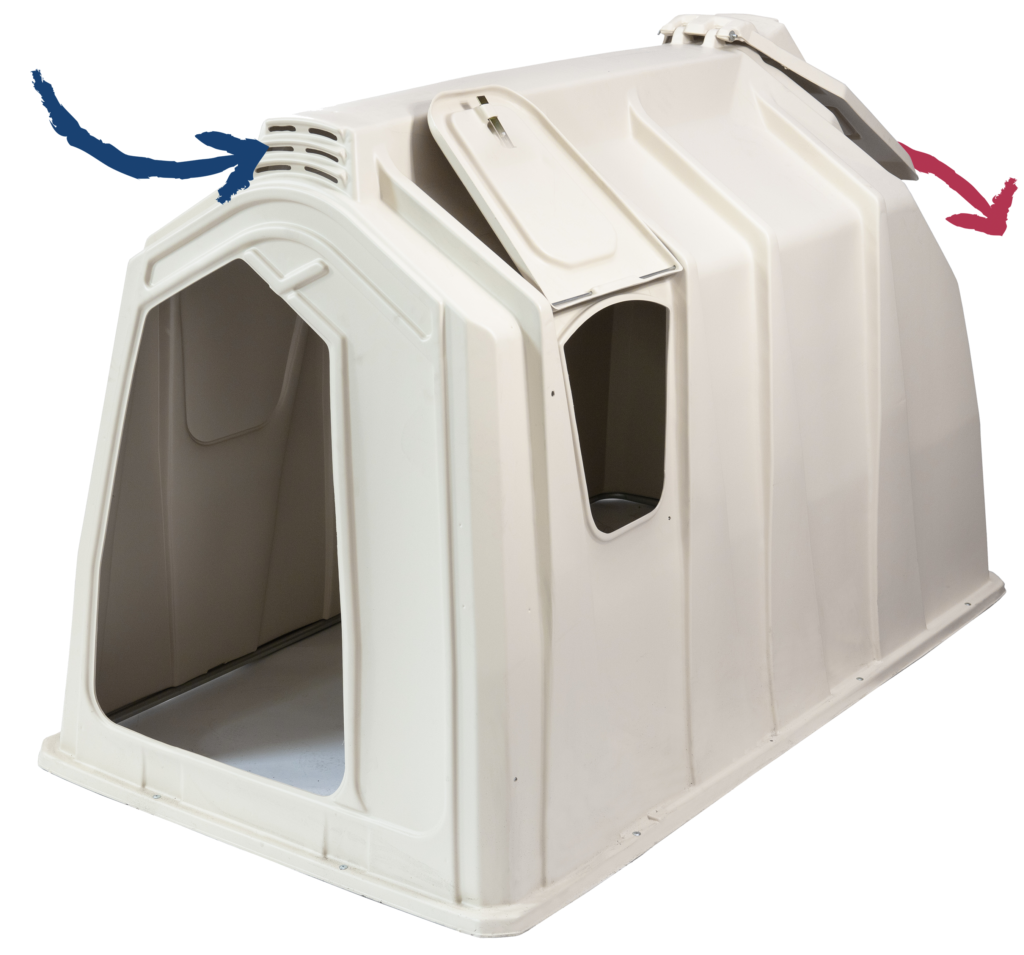Summer calf care reminders
Tips on how to keep your calves cool and hydrated during the summer months to promote growth, reduce illness, and stave off heat stress.

Because of their young immune systems, calves on milk are considered a high-risk age group. Preventing heat stress has long-lasting impacts on their health and future performance in the milking herd. When calves face heat stress, we see decreased intake, reduced growth, increased respiration, and less nutritional efficiency. With temperatures well over 80 degrees during Michigan summers, preventing heat stress can be a challenge. However, heat stress can be mitigated through a few different methods.
Proper Ventilation for Hutches
Look for hutches that have these two things: 1) ridge top vents that are wider at the bottom and 2) adjustable rear and side vents - as seen in the image below. These two vents promote ideal air movement within a hutch. Elevating the rear of the hutch can be a feasible option to improve air flow. You can get creative with what you use to raise a hutch: cement blocks, excess materials that you have lying around, wood, etc. For homemade hutches or those that do not have pre-made vents, cutting vents into the hutch would be a great first step to helping your calves stay cool.

Access to Fresh Air is Beneficial, but the Movement of Air is What Reduces the Risk for Illness
When selecting an area to put hutches, natural air movement should be a priority. Consider impediments to airflow such as neighboring structures, the height of walls or doors if you are putting calves inside a building, and anything else that may block or change the direction of airflow. Also, think about where the afternoon sun hits. Hutches are meant to provide shade and shelter for the calves during this part of the day. This goes for the same with buildings that have open sides or curtains. Providing additional shading with plastic covering will help reduce the heat inside the hutches.
Moving air will take excess moisture out of the hutch, helping keep the calves cool while reducing pathogen growth, lowering the risk for illness. Progressive Dairy featured an innovative idea to fix a ventilation problem a farm was having in their hutches - a self-made hutch ventilation system. This farm combined an old grain bin fan and plastic drainage pipe to run tubing behind the hutches and then into each individual hutch to deliver fresh air for the calves.
Continuous Access to Water at All Ages
Calves should be provided water twice daily, at minimum. According to the Farmers Assuring Responsible Management (FARM) program, all calves should have access to water by day 3 along with optimal amounts of milk for growth, development, and health. It is known through research that milk does not provide all the water needs for calves. The availability and consumption of water, separate from milk, helps prevent dehydration and helps the calf self-regulate their body temperature. Older calves can consume 2-3 gallons of water, per day, when it is offered free-choice. Calves with continuous access to water from birth had better rumen development, nutrient digestibility, and improved growth rates. Faith Cullens, with an update from Cora Okkema, produced an article that goes into detail on this.
Calves can give off around two gallons of water daily as vapor. As the air temperature rises, calves have increased respiration rate to regulate their body temperature. As a result, the air around the calf now has even greater humidity levels, causing dehydration and heat stress. Without air movement and access to water, this living environment will certainly have negative impacts on calves, both in the short and long term.
Treat Sick Calves Immediately
Hot weather naturally raises the chances of calves being dehydrated if they are not fed enough milk and water. Adding scours on top of that could spell a recipe for disaster, unless you quickly replenish lost fluids. With scours, the treatment protocol for each farm is different. Typically, some form of supplemental fluids are given, like electrolytes. Some farms have started to provide those supplemental fluids daily during the summer to all calves to encourage water intake and restore electrolytes during the summer months. Work with your local veterinarian to develop or review a protocol for treating scours and to adjust your summer feeding regimen if you want to implement preventative electrolyte feeding into your youngstock program.
Take care of your calf caretakers
The summer heat is hard on everyone. Tempers flare, patience is thin, people get tired more quickly, and the idea to take shortcuts is all too appealing. Helping your calf-care team stay cool, hydrated, and supported will directly benefit the quality of care of your calves. Some ideas include providing a dorm-fridge to store snacks and drinks and allowing your staff to take extra breaks to avoid heat-exhaustion. Teach your team about identifying the symptoms of heat-exhaustion and heat-stroke to protect one another during the summer months. Having a meeting with your team to highlight the importance of all of these topics, along with a review of your farm’s protocols, will keep everyone on the same page. Always remember to open yourself up as managers to suggestions or ideas from your staff and let their voices and opinions be heard. You never know who may come up with the next great idea that helps the whole team.
Caring for calves in the summer is just as demanding as it is in winter. These suggestions provide a starting point to evaluating your current situation and see potential areas for improvement to mitigate heat stress in your calves. If you would like assistance with reviewing your summer calf-care program, please contact Cora Okkema or your local dairy educator.



 Print
Print Email
Email